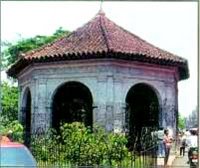
The large cross was planted in Cebu by Portuguese and Spanish explorers as ordered by Ferdinand Magellan in 1521. This is to celebrate the baptism into the Roman Catholic religion of island chief Rajah Humabon, his wife, and some 500 of their followers.
This cross is housed in a small chapel next to the Basilica Minore del Santo Nino on Magallanes Street, just in front of the city hall of Cebu City. The street is named after Magellan, Magallanes being the Spanish translation of the Portuguese explorer’s name.
A sign outside claims that the original cross is encased in the tindalo wood cross displayed in the center of the chapel. This is to protect the original cross from people who chipped away parts of the cross for sourvenir purposes or in the belief that the cross possesses miraculous powers. Some people, however, believe that the original cross had been destroyed or had disappeared after Magellan's death, and the cross is a replica that was planted there by the Spaniards after they successfully colonized the Philippines.
Magellan's Cross is a symbol of Cebu City and the chapel's image can be found in its city seal. Many other Cebu-based government and non-government organizations also use Magellan’s Cross in their seals and logos.It is also seen as the symbol of Roman Catholicism in the Philippines.
Magellan was killed on April 27, 1521 in what is now known as the Battle of Mactan. The Portuguese explorer died when his men fought Mactan natives led by the island’s chieftain, Lapu-Lapu.
The cross is a popular tourist attraction together with other Cebu historical landmarks like the Fort San Pedro, built by the Spanish conquistador who came some 40 years after Magellan, and the Basilica Minore del Sto. Niño, considered the oldest church in the Philippines.
Within the vicinity of Magellan’s Cross are Cebu guitar vendors and shellcraft and woodcraft displays. The products are popular with the locals and tourists.
This cross is housed in a small chapel next to the Basilica Minore del Santo Nino on Magallanes Street, just in front of the city hall of Cebu City. The street is named after Magellan, Magallanes being the Spanish translation of the Portuguese explorer’s name.
A sign outside claims that the original cross is encased in the tindalo wood cross displayed in the center of the chapel. This is to protect the original cross from people who chipped away parts of the cross for sourvenir purposes or in the belief that the cross possesses miraculous powers. Some people, however, believe that the original cross had been destroyed or had disappeared after Magellan's death, and the cross is a replica that was planted there by the Spaniards after they successfully colonized the Philippines.
Magellan's Cross is a symbol of Cebu City and the chapel's image can be found in its city seal. Many other Cebu-based government and non-government organizations also use Magellan’s Cross in their seals and logos.It is also seen as the symbol of Roman Catholicism in the Philippines.
Magellan was killed on April 27, 1521 in what is now known as the Battle of Mactan. The Portuguese explorer died when his men fought Mactan natives led by the island’s chieftain, Lapu-Lapu.
The cross is a popular tourist attraction together with other Cebu historical landmarks like the Fort San Pedro, built by the Spanish conquistador who came some 40 years after Magellan, and the Basilica Minore del Sto. Niño, considered the oldest church in the Philippines.
Within the vicinity of Magellan’s Cross are Cebu guitar vendors and shellcraft and woodcraft displays. The products are popular with the locals and tourists.
No comments:
Post a Comment